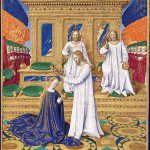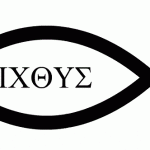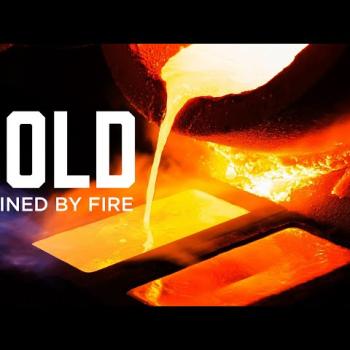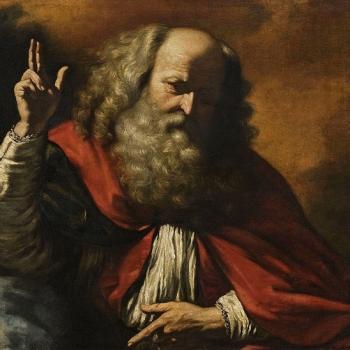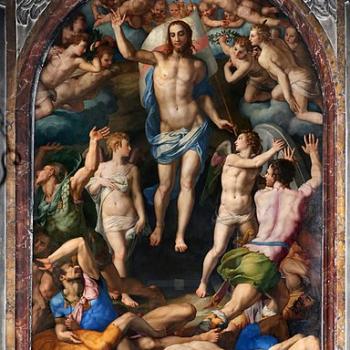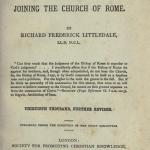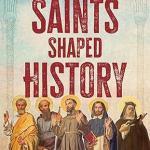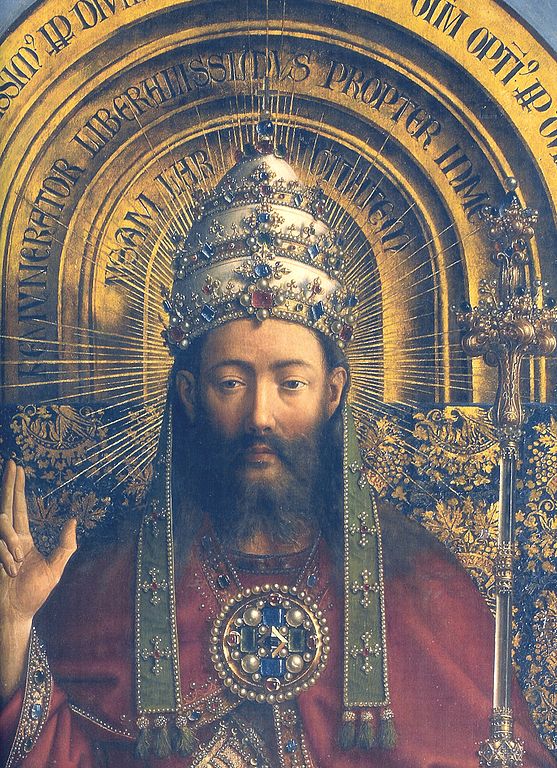
Jesus: detail of the Ghent Altarpiece (1432), by Jan van Eyck (c. 1390-1441) [public domain / Wikimedia Commons]
*****
(11-13-07)
*****
The “short version” of orthodox Christology is to remember the following formulas (the fine points and details are best left to theologians, as long as they are undeniably orthodox and are teaching opinions in total accord with infallible Catholic dogma):
1) Holy Trinity: God exists eternally in Three Persons: the Father, the Son, and the Holy Spirit: all eternal and equal in glory, honor, and essence.
2) God (i.e., Jesus, God the Son, the Second Person of the Holy Trinity) became Man (the incarnation) at a certain identifiable point in space-time history.
3) Jesus is a Divine Person.
4) It is improper to refer to Jesus as a “human person” or to claim that He contains within Himself more than one person (human and divine) or to deny that Mary is Theotokos (Mother of God or, literally, “God-bearer”). That is the heresy of Nestorianism. When we refer to “human” with regard to Jesus, it is with regard to His human nature, that He assumed at the incarnation, not His Person (which is Divine and eternal).
5) Jesus has two natures (the Hypostasis or Hypostatic Union): divine and human (the denial of his human nature is the heresy of Monophysitism; some Monophysites, however, believed in a single divine-human nature in Christ).
6) Jesus has two wills: divine and human (the assertion of a single divine-human will is the heresy of Monotheletism).
7) The orthodox Catholic notion of communicatio idiomatum holds that:
The human and the divine activities predicated of Christ in Holy Writ and in the Fathers may not be divided between persons or hypostases, the Man-Christ and the God-Logos, but must be attributed to the one Christ, the Logos become Flesh . . . It is the Divine Logos, who suffered in the flesh, was crucified, and rose again . . .
(Ludwig Ott, Fundamentals of Catholic Dogma, p. 144)
Christ’s Divine and Human characteristics and activities are to be predicated of the one Word Incarnate. (De fide.)
As Christ’s Divine Person subsists in two natures, and may be referred to either of those two natures, so human things can be asserted of the son of God and Divine things of the Son of Man.
The old Lutheran Doctrinal Theology theology inclines to the monophysitic error which posits a real transference of Divine attributes such as omniscience, omnipotence, ubiquity, by reason of the Hypostatic Union, to the human nature of Christ, and teaches that “Christ, not only as God, but also as man knows all, can do all, and is present to all created things” (formula concordiae I 8, 11).
(Ott, p. 160)
The nature of the Hypostatic Union is such that while on the one hand things pertaining to both the Divine and Human nature can be attributed to the person of Christ, on the other hand things specifically belonging to one nature cannot be predicated of the other nature. Since concrete terms (God, Son of God, Son of Man, Christ the Almighty) designate the Hypostasis and abstract terms (Godhead, humanity, omnipotence) the nature, the following rule may be laid down: communicatio idioamatum fit in concreto, non in abstracto. The communication of idioms is valid for concrete terms not for abstract ones. So, for example: The Son of Man died on the Cross; Jesus created the world. The rule is not valid if . . . the concrete term is limited to one nature. Thus it is false to say “Christ has suffered as God.” “Christ created the world as a human being.” It must also be observed that the essential parts of the human nature, body and soul are referred to the nature, whose parts they are. Thus it is false to say: “Christ’s soul is omniscient,” “Christ’s body is ubiquitous.”
Further, predication of idioms is valid in positive statements not in negative ones, as nothing may be denied to Christ which belongs to Him according to either nature. One, therefore, may not say: “The Son of God has not suffered,” “Jesus is not almighty.”
(Ott, p. 161; italics added)
To assert the contrary is the heresy of Nestorianism. The Catechism of the Catholic Church describes the Hypostatic Union as follows:
468 After the Council of Chalcedon, some made of Christ’s human nature a kind of personal subject. Against them, the fifth ecumenical council, at Constantinople in 553, confessed that “there is but one hypostasis [or person], which is our Lord Jesus Christ, one of the Trinity.” Thus everything in Christ’s human nature is to be attributed to his divine person as its proper subject, not only his miracles but also his sufferings and even his death: “He who was crucified in the flesh, our Lord Jesus Christ, is true God, Lord of glory, and one of the Holy Trinity.”
470 Because “human nature was assumed, not absorbed”, in the mysterious union of the Incarnation, the Church was led over the course of centuries to confess the full reality of Christ’s human soul, with its operations of intellect and will, and of his human body. In parallel fashion, she had to recall on each occasion that Christ’s human nature belongs, as his own, to the divine person of the Son of God, who assumed it. Everything that Christ is and does in this nature derives from “one of the Trinity”. The Son of God therefore communicates to his humanity his own personal mode of existence in the Trinity.
(see Catechism, #456-483; available online; see also the Twelve Anathemas of St. Cyril Against Nestorius, from the Acts of the Council of Ephesus: 431 A.D.)
8) Another important and dogmatically accepted aspect of trinitarianism and Christology is what is known as the perichoresis (Greek) or circumincession (Latin). Fr. John A. Hardon. S.J., in his Modern Catholic Dictionary (Doubleday, 1980, 415-416) precisely defines it:
The penetration and indwelling of the three persons reciprocally in one another. In the Greek conception of the Trinity there is an emphasis on the mutual penetration of the three persons, thus bringing out the unity of the divine essence. In the Latin idea . . . the stress is more on the internal processions of the three divine persons. In both traditions, however, the fundamental basis of the Trinitarian perichoresis is the one essence of the three persons in God.
For more on perichoresis, see my papers: Prayer to Jesus in the New Testament and Circumincession: 50 Cent Trinitarian Word.
Perichoresis is also specifically applied to the two natures of Christ. Biblical indications of this doctrine can be found in the following passages (RSV):
John 10:30: I and the Father are one.
John 10:38: . . . believe the works, that you may know and understand that the Father is in me and I am in the Father.
John 14:9-11: Jesus said to him, “Have I been with you so long, and yet you do not know me, Philip? He who has seen me has seen the Father; how can you say, `Show us the Father’? Do you not believe that I am in the Father and the Father in me? The words that I say to you I do not speak on my own authority; but the Father who dwells in me does his works. Believe me that I am in the Father and the Father in me . . .
See also the various biblical ways of describing the indwelling of Christian believers, proving that all three persons of the Holy Trinity are involved (not just the Holy Spirit):
[the following verses are KJV]
I) Jesus and the Father Indwell Christian Believers
JOHN 14:23 Jesus answered and said unto him, If a man love me, he will keep my words: and my Father will love him, and we will come unto him, and make our abode with him.
II) Jesus Indwells Christian Believers
JOHN 14:18 I will not leave you comfortless: I will come to you. {cf. Jn 14:16-17}
JOHN 14:20 At that day ye shall know that I {am} in my Father, and ye in me, and I in you.
JOHN 15:4 Abide in me, and I in you. As the branch cannot bear fruit of itself, except it abide in the vine; no more can ye, except ye abide in me.
JOHN 17:23 I in them, and thou in me, that they may be made perfect in one; . . .
III) God the Holy Spirit Indwells Christian Believers
1 CORINTHIANS 3:16-17 Know ye not that ye are the temple of God, and {that} the Spirit of God dwelleth in you? (17) If any man defile the temple of God, him shall God destroy; for the temple of God is holy, which {temple} ye are.
JOHN 14:16-17 And I will pray the Father, and he shall give you another Comforter, that he may abide with you for ever; (17) {Even} the Spirit of truth; whom the world cannot receive, because it seeth him not, neither knoweth him: but ye know him; for he dwelleth with you, and shall be in you. {cf. Jn 14:18 below}
ROMANS 8:9,11 But ye are not in the flesh, but in the Spirit, if so be that the Spirit of God dwell in you. Now if any man have not the Spirit of Christ, he is none of his . . . (11) But if the Spirit of him that raised up Jesus from the dead dwell in you, he that raised up Christ from the dead shall also quicken your mortal bodies by his Spirit that dwelleth in you. {cf. Rom 8:10 below}
1 CORINTHIANS 2:12 Now we have received, not the spirit of the world, but the spirit which is of God; that we might know the things that are freely given to us of God.
1 CORINTHIANS 6:19 What? know ye not that your body is the temple of the Holy Ghost {which is} in you, which ye have of God, and ye are not your own? {cf. to 1 Cor 3:16}
GALATIANS 4:6 And because ye are sons, God hath sent forth the Spirit of his Son into your hearts, crying, Abba, Father.
IV) “God” (Divine Person Not Specified) Indwells Christian Believers
(Arguably God the Father)2 CORINTHIANS 6:16 And what agreement hath the temple of God with idols? for ye are the temple of the living God; as God hath said, I will dwell in them, and walk in {them}; and I will be their God, and they shall be my people. {cf. Ex 29:45, Jer 31:33, Ezek 37:27}
V) God the Father and God the Holy Spirit Indwell Christian Believers
1 JOHN 3:24 . . . And hereby we know that he abideth in us, by the Spirit which he hath given us.
1 JOHN 4:12-16 . . . If we love one another, God dwelleth in us, and his love is perfected in us. (13) Hereby know we that we dwell in him, and he in us, because he hath given us of his Spirit. (14) And we have seen and do testify that the Father sent the Son {to be} the Saviour of the world. (15) Whosoever shall confess that Jesus is the Son of God, God dwelleth in him, and he in God. (16) And we have known and believed the love that God hath to us. God is love; and he that dwelleth in love dwelleth in God, and God in him. {cf. Neh 9:20, Jn 14:26, 15:26, 16:7-8,13-15, Rom 8:14, 2 Cor 13:14}
VI) God the Holy Spirit, and God the Son, Jesus, Indwell Christian Believers
ROMANS 8:10 And if Christ {be} in you, the body {is} dead because of sin; but the Spirit {is} life because of righteousness. {cf. Rom 8:9}
VII) God the Father Indwells Christian Believers
1 JOHN 3:24 And he that keepeth his commandments dwelleth in him, and he in him . . .
We don’t have nearly as much of a problem today with the three heresies mentioned above (though a lot of Protestantism-in-practice and liberal Catholic and Protestant theology has strong Nestorian tendencies, and some have argued that Calvin’s Christology was literally Nestorian), but they were huge problems in the first seven centuries of the Church, especially in the East.
Today we have the luxury of orthodox councils and popes having carefully defined and explained all these doctrines. But unfortunately many Catholics (not to mention non-Catholic Christians) are insufficiently acquainted with orthodox Christology and so (often inadvertently) fall into various errors.
We all do need to do some study, at least enough to grasp the basic distinctions above, concerning persons, natures, wills, essences, etc., so we don’t fall into heresies. This stuff may seem very abstract and not-so-important to us, yet all error can lead one far astray, and (false) ideas have consequences. Christology is at the center of Christianity, so we should all spend some time learning it.
Folks certainly learn many other complicated things (quantum physics, trigonometry, income taxes, engineering, auto mechanics, computer programming, advanced medicine, how to operate a DVD player, etc.). These things can only be simplified so much, because they are quite complex and nuanced by nature (no pun intended!).
Additional, More Technical Distinctions and Clarifications
Jesus was neither a man nor a human being before the Incarnation. “God became man.” Jesus is a Divine Person with a human nature and a divine nature. To say that Jesus is a “human person” is the Christological heresy of Nestorianism (see, e.g., Ludwig Ott, Fundamentals of Catholic Dogma, pp. 143-146).
St. Thomas Aquinas wrote about the “person” / “nature” distinction:
Augustine [Fulgentius] says (De Fide ad Petrum ii) that “God assumed the nature, not the person, of man.”
I answer that, A thing is said to be assumed inasmuch as it is taken into another. Hence, what is assumed must be presupposed to the assumption, as what is moved locally is presupposed to the motion. Now a person in human nature is not presupposed to assumption; rather, it is the term of the assumption, as was said (3, 1,2). For if it were presupposed, it must either have been corrupted–in which case it was useless; or it remains after the union–and thus there would be two persons, one assuming and the other assumed, which is false, as was shown above (2, 6). Hence it follows that the Son of God nowise assumed a human person.
Reply to Objection 1. The Son of God assumed human nature “in atomo,” i.e. in an individual, which is no other than the uncreated suppositum, the Person of the Son of God. Hence it does not follow that a person was assumed.(Summa Theologica, III, 4, 2)
Theologian Ludwig Ott, in the same section in his book on the Hypostatic Union (pp. 150-151) writes:
Christ’s death dissolved the connection between body and soul — Christ was therefore during the three days not “man” that is, a compositum of body and soul ([St. Thomas Aquinas], Summa Theologica, III, 50, 4) — but His death did not dissolve the attachment of Godhead and humanity, or of their parts. Even after their separation the body and soul separately remained hypostatically united with the divine Logos.
St. Thomas wrote in the noted section:
When the higher [species] is removed, so is the lower. But the living or animated being is a higher species than animal and man, because an animal is a sensible animated substance. Now during those three days of death Christ’s body was not living or animated. Therefore He was not a man.
I answer that, It is an article of faith that Christ was truly dead: hence it is an error against faith to assert anything whereby the truth of Christ’s death is destroyed. Accordingly it is said in the Synodal epistle of Cyril [Act. Conc. Ephes. P. I, cap. xxvi]: “If any man does not acknowledge that the Word of God suffered in the flesh, and was crucified in the flesh and tasted death in the flesh, let him be anathema.” Now it belongs to the truth of the death of man or animal that by death the subject ceases to be man or animal; because the death of the man or animal results from the separation of the soul, which is the formal complement of the man or animal. Consequently, to say that Christ was a man during the three days of His death simply and without qualification, is erroneous. Yet it can be said that He was “a dead man” during those three days.
However, some writers have contended that Christ was a man during those three days, uttering words which are indeed erroneous, yet without intent of error in faith: as Hugh of Saint Victor, who (De Sacram. ii) contended that Christ, during the three days that followed His death, was a man, because he held that the soul is a man: but this is false, as was shown in I, 75, 4]. Likewise the Master of the Sentences (iii, D, 22) held Christ to be a man during the three days of His death for quite another reason. For he believed the union of soul and flesh not to be essential to a man, and that for anything to be a man it suffices if it have a soul and body, whether united or separated: and that this is likewise false is clear both from what has been said in I, 75, 4, and from what has been said above regarding the mode of union (2] , 5).
I know it’s very “heavy” (my head’s spinning, too, believe me) but Christology and Trinitarianism always will be. These are deep waters indeed, and barely comprehensible to us.
As for the additional question of theophanies (in relation to the incarnation), Fr. John A. Hardon, S.J., defines this phenomenon in his Modern Catholic Dictionary (p. 538):
A direct communication or appearance by God to human beings . . . These theophanies were temporary manifestations. They were not like the Incarnation, which, though it began in time, will continue for all eternity.
A Protestant site (I don’t want to reference it because there may be some Christological errors in it, on various sub-pages), writes (in agreement with Catholic doctrine):
A theophany is a manifestation of God in the Bible that is tangible to the human senses. In its most restrictive sense, it is a visible appearance of God in the Old Testament period often, but not always, in human form. . . . every theophany wherein God takes on human form foreshadows the incarnation . . .
Related Reading:
Jesus is God: Biblical Proofs [1982; slightly revised in 1997]
*****


